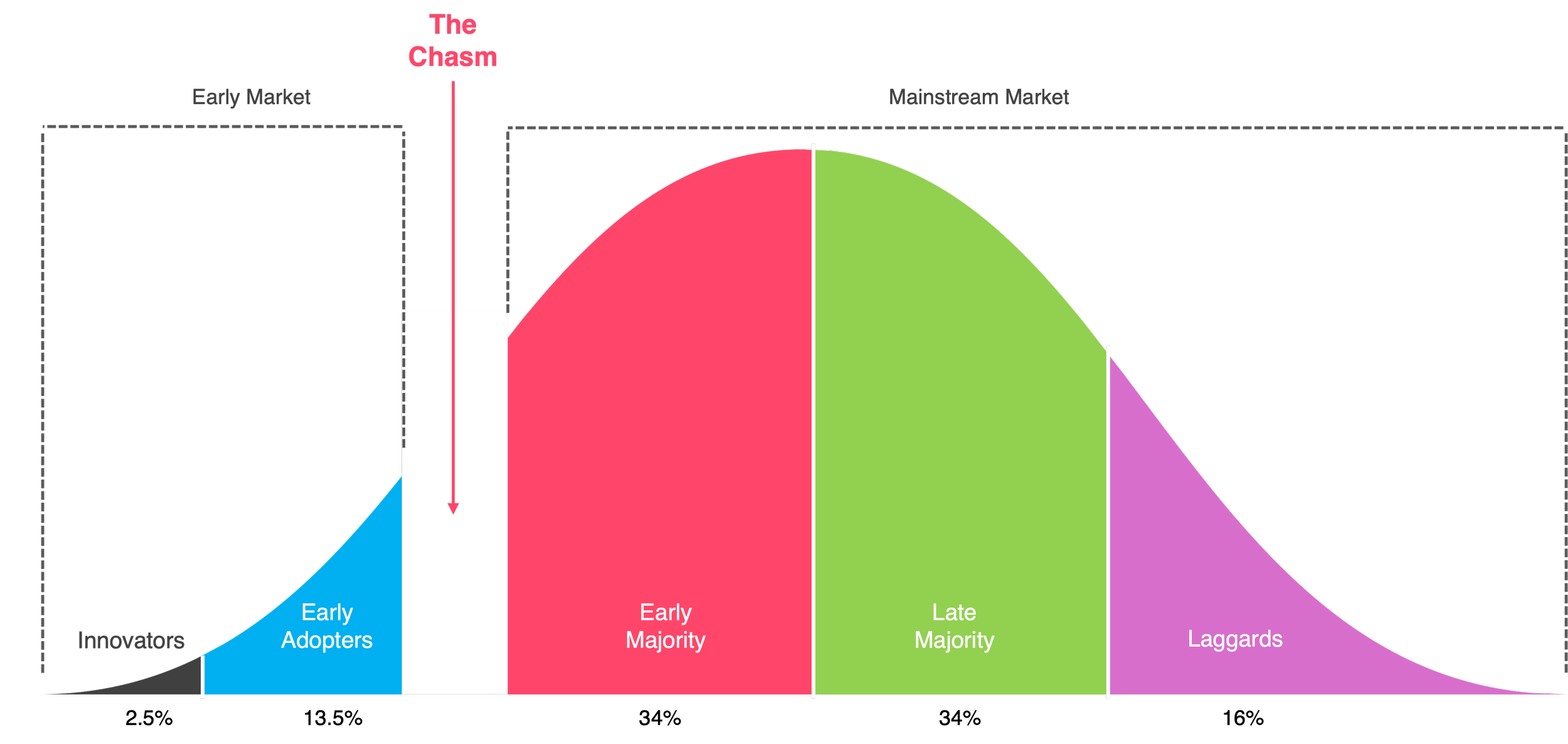Crossing the AI Chasm: Why 2025 Demands a Bold Leap Forward
By the GAPx Strategy Team
In 1991, Geoffrey Moore's seminal work Crossing the Chasm introduced the concept of a critical gap between early adopters and the early majority in the technology adoption lifecycle. This "chasm" represents a formidable hurdle that many innovations fail to overcome, preventing them from achieving mainstream success. Fast forward to 2025, and artificial intelligence (AI) finds itself at this pivotal juncture. The question now is not whether AI will cross the chasm, but how—and what lies beyond.
Crossing The Chasm
The Tipping Point: AI's Accelerated Adoption
Recent indicators suggest that AI is making significant strides toward mainstream adoption. OpenAI, for instance, has emerged as a leading force in business AI adoption, outpacing competitors in acquiring new enterprise clients, as highlighted by the Ramp AI Index. This surge reflects a growing confidence in AI's capabilities and its potential to drive business value. (Ramp)
Moreover, Salesforce is positioning itself as a global leader in agentic AI, aiming to leverage this emerging technology to expand its dominance beyond the Customer Relationship Management (CRM) sector. Agentic AI refers to autonomous systems capable of independent action and decision-making. Salesforce, under the leadership of Mr. Perez, has rebranded its efforts as “Agentforce” and is integrating these AI capabilities across its platforms to enhance customer service, marketing, and productivity. (Salesforce)
These developments indicate that AI is not only gaining traction among innovators and early adopters but is also beginning to appeal to the early majority—a critical step in crossing the chasm.
The Imperative for Speed: No Time to 'Wait and See'
The rapid pace of AI development leaves little room for hesitation. Companies that delay adoption risk falling behind as AI reshapes industry standards and expectations. The traditional 'wait and see' approach is no longer viable; instead, organizations must proactively embrace AI to remain competitive.
This urgency is underscored by the fact that nearly all companies are investing in AI, but only 1 percent of leaders call their companies “mature” on the deployment spectrum, meaning that AI is fully integrated into workflows and drives substantial business outcomes. The gap between ambition and reality highlights the need for decisive action and comprehensive strategies to harness AI's full potential. (McKinsey)
As Seth Godin often reminds us, tension is the engine of change. The adoption curve isn’t a gentle slope – it’s a cliff edge between relevance and redundancy. In the AI space, the chasm isn’t just a strategic inflection point; it’s a test of nerve. Companies that play it safe and wait for certainty will watch as competitors sprint past them. Godin calls this the moment when leaders must choose to be “remarkable” or risk being invisible. And in 2025, remarkable looks like running across the chasm while building new AI-native muscles mid-air. (Seth Godin)
Digital Transformation: The Bridge Across the Chasm
True digital transformation is the most effective route to crossing the AI chasm. This involves more than just implementing new technologies; it requires a fundamental shift in organisational culture, processes, and mindset. Companies must reimagine their operations, integrating AI into every facet of their business to drive innovation and efficiency.
According to EY, the integration of AI into enterprise operations is set to reach an inflection point in 2025, as organisations transition from experimental AI deployments to comprehensive digital transformation strategies. This shift marks a departure from traditional automation, moving towards systems where AI agents work autonomously alongside human employees. (EY)
By embracing digital transformation, organisations can unlock new levels of productivity and innovation, positioning themselves to thrive in the AI-driven future.
Seizing the Opportunity: A Call to Action
As AI continues its journey across the chasm, organisations must be proactive in addressing the challenges that lie ahead. A recent McKinsey report highlights that employees are more ready for AI than their leaders imagine. In fact, they are already using AI on a regular basis; they are three times more likely than leaders realise to believe that AI will replace 30% of their work in the next year and are eager to gain AI skills. This underscores the urgency for companies to move swiftly and strategically in adopting AI technologies to remain competitive. (McKinsey)
The decisions made in 2025 will have lasting implications. Companies that embrace AI thoughtfully and strategically will be well-equipped to thrive in a future where AI is integral to operations, decision-making, and value creation.
Image Credit: Conny Schneider https://unsplash.com/@choys_


